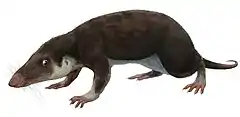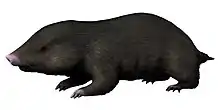Storchodon
Storchodon is an extinct genus of morganucodont mammaliaforms from the Late Jurassic (Kimmeridgian) of Germany. Its only species is Storchodon cingulatus, which is known exclusively from a single upper molar found at the Süntel Formation of Lower Saxony.[1]
| Storchodon Temporal range: | |
|---|---|
| Scientific classification | |
| Domain: | Eukaryota |
| Kingdom: | Animalia |
| Phylum: | Chordata |
| Clade: | Synapsida |
| Clade: | Therapsida |
| Clade: | Cynodontia |
| Clade: | Mammaliaformes |
| Order: | †Morganucodonta |
| Genus: | †Storchodon Martin et al., 2019 |
| Species: | †S. cingulatus |
| Binomial name | |
| †Storchodon cingulatus Martin et al., 2019 | |
Etymology
The generic name Storchodon honours the German palaeontologist Gerhard Storch, whereas the specific epithet cingulatus is a reference to the prominent cingulum of the molar.[1]
Description
Storchodon was large for a morganucodont; the holotype molar has a length of 3.07 millimetres (0.121 in), which among morganucodonts is exceeded only by the holotype of Paceyodon davidi. This large size may be a case of insular gigantism.[1] As in other morganucodonts, the molar has a triconodont shape, with the three main cusps A, B and C being set in a straight line. Cusp D is relatively large, and unlike in for example Morganucodon, it is placed at an oblique angle relative to the main cusps.[1]
References
- Martin, T.; Averianov, A. O.; Jäger, K. R. K.; Schwermann, A. H.; Wings, O. (2019). "A large morganucodontan mammaliaform from the Late Jurassic of Germany" (PDF). Fossil Imprint. 75 (3–4): 504–509. doi:10.2478/if-2019-0030.





